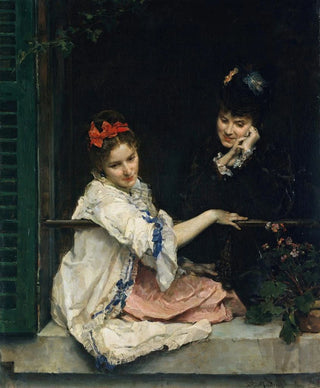Art print | Girls at the window - Raimundo de Madrazo y Garreta


View from behind

Frame (optional)
In the enchanting world of 19th-century Spanish painting, the art print "Filles à la fenêtre" by Raimundo de Madrazo y Garreta stands out for its delicacy and intimate atmosphere. This piece, capturing a fleeting moment of everyday life, transports us to a realm where light and shadow dance harmoniously. The two young girls, frozen in a contemplative pose, seem to detach from the outside tumult to immerse themselves in their thoughts. This work, both simple and deeply emotional, invites the viewer to reflect on the nature of childhood, innocence, and the passage of time.
Style and uniqueness of the art print
Madrazo's style is characterized by an exceptional mastery of light and color, which gives his works an almost tangible atmosphere. In "Filles à la fenêtre," delicate nuances of the palette, ranging from soft pastels to more subdued tones, create a visual harmony that immediately captures the eye. The artist plays with reflections of light on the faces of the young girls, emphasizing their youthful beauty and vulnerability. The choice of composition, focused on the female figures, highlights their silent interaction with the outside world while revealing a fascinating psychological depth. Madrazo thus succeeds in capturing an essence of femininity, imbued with softness and melancholy, that still resonates today.
The artist and his influence
Raimundo de Madrazo y Garreta, born in 1841, is one of the major representatives of the Spanish artistic movement of the 19th century. Coming from a family of artists, he developed a personal style that combines academic tradition with contemporary innovations. His work is marked by a sensitivity to beauty and the complexity of human emotions. Madrazo managed to establish himself on the artistic scene, not only in Spain but also internationally, influencing many artists of his time. His approach to genre painting, which highlights scenes of daily life with a touch of romanticism, paved the way for future generations of artists. Through his works

Matte finish

View from behind

Frame (optional)
In the enchanting world of 19th-century Spanish painting, the art print "Filles à la fenêtre" by Raimundo de Madrazo y Garreta stands out for its delicacy and intimate atmosphere. This piece, capturing a fleeting moment of everyday life, transports us to a realm where light and shadow dance harmoniously. The two young girls, frozen in a contemplative pose, seem to detach from the outside tumult to immerse themselves in their thoughts. This work, both simple and deeply emotional, invites the viewer to reflect on the nature of childhood, innocence, and the passage of time.
Style and uniqueness of the art print
Madrazo's style is characterized by an exceptional mastery of light and color, which gives his works an almost tangible atmosphere. In "Filles à la fenêtre," delicate nuances of the palette, ranging from soft pastels to more subdued tones, create a visual harmony that immediately captures the eye. The artist plays with reflections of light on the faces of the young girls, emphasizing their youthful beauty and vulnerability. The choice of composition, focused on the female figures, highlights their silent interaction with the outside world while revealing a fascinating psychological depth. Madrazo thus succeeds in capturing an essence of femininity, imbued with softness and melancholy, that still resonates today.
The artist and his influence
Raimundo de Madrazo y Garreta, born in 1841, is one of the major representatives of the Spanish artistic movement of the 19th century. Coming from a family of artists, he developed a personal style that combines academic tradition with contemporary innovations. His work is marked by a sensitivity to beauty and the complexity of human emotions. Madrazo managed to establish himself on the artistic scene, not only in Spain but also internationally, influencing many artists of his time. His approach to genre painting, which highlights scenes of daily life with a touch of romanticism, paved the way for future generations of artists. Through his works






